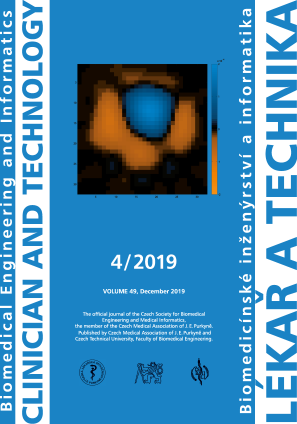THE EFFECT OF FRAME RATE AND CALIBRATION ON LUNG MONITORING WITH ELECTRICAL IMPEDANCE TOMOGRAPHY
DOI:
https://doi.org/10.14311/CTJ.2019.4.01Keywords:
electrical impedance tomography (EIT), EIT calibration, frame rate, lung monitoringAbstract
Electrical impedance tomography (EIT) is a non-invasive method that records changes in tissue impedance in the selected cross-section of the body and is mainly used to monitor patient lung ventilation. The aim of this study was to analyze the effect of the set frame rate and how calibration of the EIT system effects final record when monitoring lungs using EIT system PulmoVista 500 (Dräger Medical, Germany). Ten healthy male volunteers were measured with frame rates 10, 20, 30, 40 and 50 Hz for analysis, followed by calibrated and uncalibrated measurements. The subjects were breathing spontaneously in horizontal supine position. In the frame rate analysis, data with the references 30 and 50 Hz were compared with others using a paired T-test. The same test was used for comparing data from a calibrated and uncalibrated records. This study shows that the effect of both frame rate and calibration is negligible at the significance level of 5%.
Downloads
Published
Issue
Section
License
Copyright (c) 2020 Kristyna Koldova, David Slajfercik

This work is licensed under a Creative Commons Attribution 4.0 International License.
Authors who publish with this journal agree to the following terms:
- Authors retain copyright and grant the journal right of the first publication with the work simultaneously licensed under a Creative Commons Attribution License (https://creativecommons.org/licenses/by/4.0/) that allows others to share the work with an acknowledgment of the work's authorship and initial publication in CTJ.
- Authors are able to enter into separate, additional contractual arrangements for the non-exclusive distribution of the journal’s published version of the work (e.g., post it to an institutional repository or publish it in a book), with an acknowledgment of its initial publication in this journal.
- Authors are permitted and encouraged to post their work online (e.g., in institutional repositories or on their website or ResearchGate) prior to and during the submission process, as it can lead to productive exchanges.
CTJ requires that all of the content of the manuscript has been created by its respective authors or that permission to use a copyrighted material has been obtained by the authors before submitting the manuscript to CTJ. CTJ requires that authors have not used any copyrighted material illegally, as for example a picture from another journal or book, a photo, etc. It is the author’s responsibility to use only materials not violating the copyright law. When in doubt, CTJ may ask the authors to supply the pertinent permission or agreement about the use of a copyrighted material.
The opinions expressed in CTJ articles are those of authors and do not necessarily reflect the views of the publishers or the Czech Society for Biomedical Engineering and Medical Informatics.


